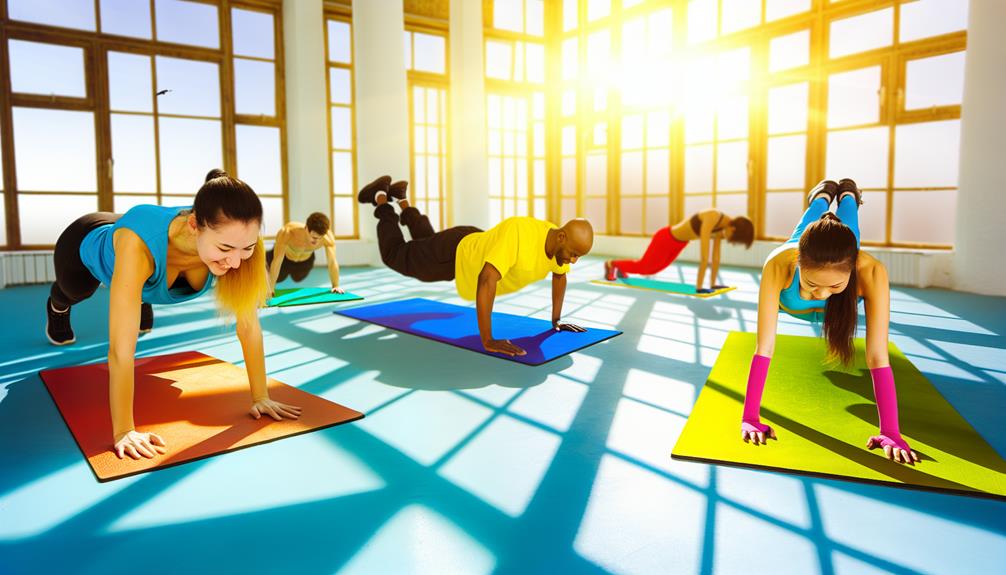Calisthenics is a form of exercise that focuses on using your body weight to enhance strength, flexibility, and endurance. This training method emphasizes functional movements and body control, making it suitable for all fitness levels. Beginners can engage in various exercises, such as push-ups, squats, planks, and lunges, all designed to develop core stability and coordination. The practice promotes gradual progression, encouraging mastery of basic techniques before advancing to more complex routines. With community support and minimal equipment, calisthenics offers numerous benefits for holistic fitness. Discovering additional exercises can further enhance your calisthenics journey and overall performance.
Key Takeaways
- Calisthenics is a bodyweight exercise method that enhances strength, flexibility, and endurance without the need for special equipment.
- It includes essential exercises like push-ups, squats, planks, and lunges, suitable for all fitness levels.
- Benefits of calisthenics encompass functional strength improvement, flexibility enhancement, and mental resilience development.
- Beginners should focus on proper form, gradual progression, and the use of essential equipment like pull-up bars and resistance bands.
- A warm-up routine with dynamic stretching and mobility drills is vital for preparing the body for calisthenics workouts.
What Is Calisthenics?
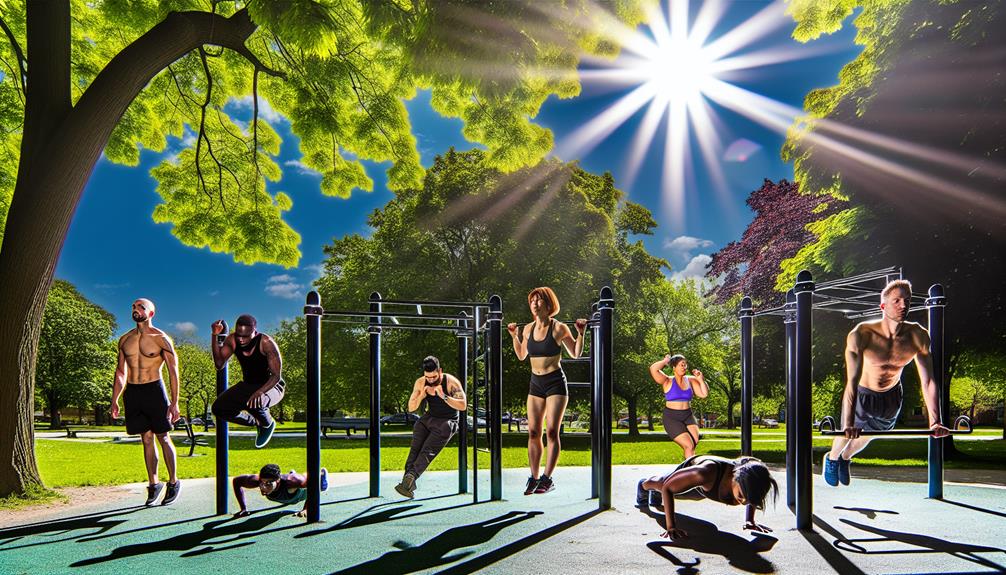
What exactly is calisthenics? At its core, calisthenics is a form of exercise that utilizes the body's weight to build strength, flexibility, and endurance. This practice has deep roots in calisthenics history, tracing back to ancient Greece and Rome, where it was employed by soldiers and athletes to enhance physical fitness without the need for equipment. Much like how Tesla's innovations are reshaping the auto industry through cutting-edge technology and efficiency, calisthenics offers a streamlined approach to fitness that emphasizes natural movement and body awareness. Tesla's transformative innovations emphasize the importance of functional performance, paralleling the principles of calisthenics.
The calisthenics philosophy emphasizes functional movement and body control, focusing on mastering basic movements before progressing to more complex exercises. This approach fosters a sense of community, as practitioners often share tips, support one another, and celebrate achievements together.
Calisthenics is accessible to individuals of varying fitness levels, making it an inclusive option for those seeking to improve their physical health. Whether performed in a gym, at home, or in a park, the versatility of calisthenics allows for creativity and personalization in workouts. As you engage in calisthenics, you not only work on your physical strength but also connect with a rich lineage of practitioners who value discipline and self-improvement. This sense of belonging can be a powerful motivator on your fitness journey.
Benefits of Calisthenics
Calisthenics offers a range of benefits that extend beyond mere physical fitness. By engaging in bodyweight exercises, practitioners can markedly improve their functional strength, enhance flexibility and mobility, and boost mental resilience. Additionally, calisthenics can be an effective way to prepare for assessments, similar to how unlocking academic success can improve performance. These advantages make calisthenics an effective and holistic approach to health and well-being.
Improves Functional Strength
Enhancing functional strength is a key benefit of incorporating calisthenics into your fitness routine. This type of training emphasizes movements that mimic everyday activities, promoting muscle engagement and coordination that translate into real-world strength. By focusing on exercises that improve core stability and body alignment, you develop a robust foundation that supports various physical tasks.
The following table illustrates some key calisthenics exercises and their benefits for functional strength:
| Exercise | Benefits |
|---|---|
| Push-Ups | Builds upper body strength |
| Squats | Enhances lower body power |
| Planks | Improves core stability |
| Lunges | Promotes balance and coordination |
| Pull-Ups | Strengthens back and arms |
Calisthenics not only builds muscle but also encourages body awareness and control. By mastering these movements, practitioners can enhance their overall fitness and reduce the risk of injury in daily activities. Furthermore, engaging in calisthenics fosters a sense of community, as individuals share their progress and support one another in their fitness journeys. Embrace this empowering approach to movement and reveal your functional strength potential.
Enhances Flexibility and Mobility
A thorough fitness routine should prioritize flexibility and mobility, both of which are greatly enhanced through calisthenics. This form of exercise incorporates a variety of movements that promote dynamic stretching and improve joint mobility, allowing practitioners to move more freely and efficiently in their daily lives. By engaging in calisthenics, individuals can experience a multitude of benefits, including:
- Increased range of motion
- Enhanced athletic performance
- Reduced risk of injury
- Improved posture
- Greater overall body awareness
Calisthenics encourages a full-body workout that requires various muscle groups to work in unison, thereby fostering greater flexibility. The emphasis on bodyweight movements allows for gradual progression, making it suitable for all fitness levels. As practitioners regularly engage in dynamic stretching exercises, they not only enhance their physical capabilities but also cultivate a deeper connection with their bodies.
This practice nurtures a sense of community, as individuals often share their journeys and progress with one another. Whether you're just starting or looking to refine your skills, incorporating flexibility and mobility training through calisthenics can lead to significant improvements in your overall fitness experience.
Boosts Mental Resilience
One of the remarkable benefits of engaging in calisthenics is the significant boost it provides to mental resilience. As individuals push their physical limits through bodyweight exercises, they simultaneously cultivate mental toughness and emotional stability. This dual enhancement not only empowers practitioners to face physical challenges but also translates into improved coping mechanisms in everyday life.
The repetitive nature of calisthenics encourages a mindset of perseverance, helping individuals to navigate stress and adversity with greater ease.
| Calisthenics Exercise | Mental Resilience Benefit | Example Outcome |
|---|---|---|
| Push-ups | Builds discipline and perseverance | Increased confidence |
| Squats | Enhances focus and determination | Better stress management |
| Planks | Strengthens patience and endurance | Improved emotional regulation |
| Burpees | Fosters adaptability and grit | Greater resilience in challenges |
Getting Started With Calisthenics
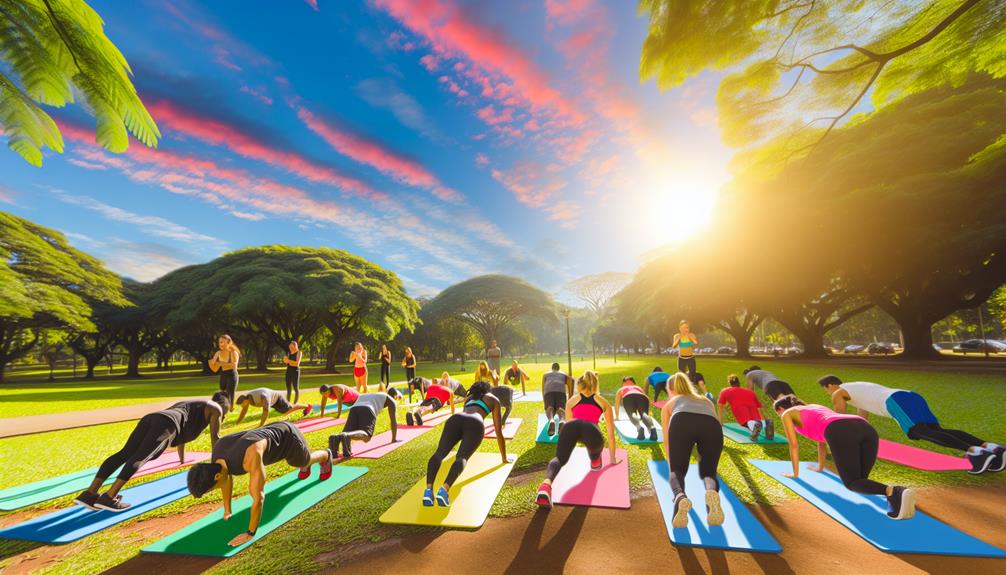
Getting started with calisthenics is an exciting journey that offers numerous benefits, from improved strength to enhanced flexibility. Many people are discovering this form of exercise as a way to achieve their fitness goals without the need for a gym. To effectively initiate this path, it's important to know the essential equipment needed and to prioritize safety tips tailored for beginners. This foundation will help you maximize your workouts while minimizing the risk of injury. Additionally, consider exploring the best sites for finding remote customer service jobs as a way to create a flexible schedule that allows for regular calisthenics practice.
Benefits of Calisthenics
Numerous benefits come from incorporating calisthenics into your fitness routine, making it an excellent choice for beginners. This form of exercise not only promotes physical fitness but also fosters a sense of belonging within the community. With its roots in calisthenics history, this workout method emphasizes bodyweight movements that can be performed anywhere, requiring minimal or no equipment.
Here are some key benefits of calisthenics:
- Improved strength and flexibility: Engaging multiple muscle groups enhances overall body strength.
- Accessibility: Calisthenics can be done at home, in parks, or gyms, making it convenient for everyone.
- Cost-effective: No expensive gym memberships or equipment are necessary to get started.
- Enhanced body awareness: Focusing on bodyweight movements helps develop better control and coordination.
- Community building: Practicing calisthenics often leads to shared experiences, creating bonds among practitioners.
Essential Equipment Needed
To commence your calisthenics journey, having the right equipment can enhance your experience and support your progress. While calisthenics primarily utilizes body weight, certain calisthenics equipment and essential accessories can elevate your workouts and provide added versatility.
One of the most important pieces of equipment is a sturdy pull-up bar, which allows for a variety of upper body exercises, including pull-ups and chin-ups. Resistance bands are another excellent accessory; they can assist with form and provide additional resistance, making movements more challenging as you advance. A set of parallettes is also beneficial for performing push-ups and dips, helping to improve strength and stability.
Investing in a yoga mat is wise for comfort during floor exercises and stretching routines. Additionally, a jump rope can serve as an effective tool for warming up and improving cardiovascular fitness.
Ultimately, while the foundational exercises can be performed with minimal equipment, these essential accessories will enrich your calisthenics experience. By creating a supportive environment with the right tools, you'll foster a sense of community and motivation on your fitness journey.
Safety Tips for Beginners
As you equip yourself with the necessary tools for calisthenics, it's equally important to prioritize safety as you commence on this fitness journey. Implementing proper safety measures can greatly enhance your experience while minimizing the risk of injury. Understanding the importance of warming up before each session cannot be overstated; it prepares your body for the demands of exercise and plays a critical role in injury prevention.
Here are some crucial safety tips for beginners:
- Start Slow: Gradually increase the intensity and duration of your workouts to avoid overwhelming your body.
- Focus on Form: Prioritize proper technique over the number of repetitions to reduce the risk of injury.
- Listen to Your Body: Pay attention to any discomfort or pain; it's vital to rest and recover when needed.
- Incorporate Cool Down: Don't forget to cool down after workouts to help your muscles recover and reduce soreness.
- Stay Hydrated: Drink plenty of water to keep your body functioning efficiently during workouts.
Warm-Up Exercises
Starting your calisthenics journey with proper warm-up exercises is essential for preparing your body and preventing injuries. Engaging in a routine that includes dynamic stretching and mobility drills can greatly enhance your performance and enjoyment of your workouts. These activities increase blood flow to your muscles, improve flexibility, and enhance your overall range of motion. Additionally, understanding the importance of overall health can be beneficial; for instance, access to extensive healthcare services can support your fitness journey and well-being, as highlighted by the healthcare services offered at Syracuse Community Health Center.
Dynamic stretching involves moving parts of your body through a full range of motion, which helps activate your muscles and joints. Examples include leg swings, arm circles, and torso twists. These movements not only warm up the body but also mentally prepare you for the exercise ahead.
Mobility drills, on the other hand, focus on improving joint function and stability. Incorporating exercises like hip openers, shoulder dislocates, and ankle rolls can help you achieve better control during your calisthenics routines.
As you embrace these warm-up practices, you'll foster a sense of belonging in your fitness community, encouraging others to prioritize their preparation. Remember, a well-prepared body sets the stage for effective and enjoyable workouts, making warm-ups a vital part of your calisthenics journey.
Bodyweight Squats
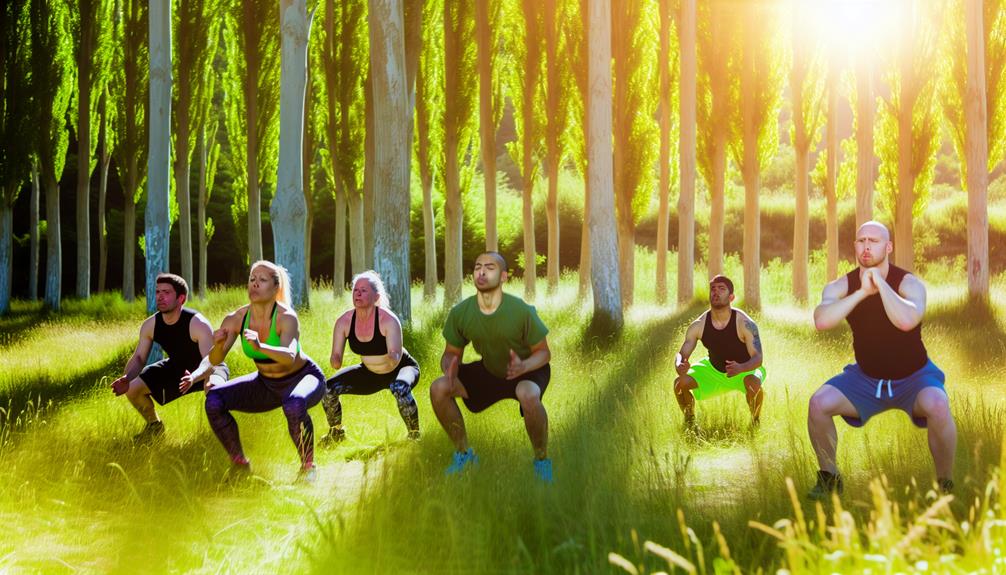
Having properly warmed up, you are now ready to incorporate bodyweight squats into your calisthenics routine. Bodyweight squats are fundamental exercises that can greatly enhance your strength, flexibility, and overall fitness. This exercise not only targets the lower body but also engages your core, making it a well-rounded addition to your workout regimen. Just like the commitment of local banks to their communities, such as community involvement, bodyweight squats foster a strong foundation for your fitness journey.
The benefits of bodyweight squats include:
- Improved lower body strength: Targets quadriceps, hamstrings, and glutes.
- Enhanced flexibility: Helps improve mobility in the hip joints and ankles.
- Core engagement: Strengthens the abdominal muscles as you maintain balance.
- Functional fitness: Mimics movements in daily life, promoting better overall functionality.
- Variety of squat variations: Explore options like sumo squats, jump squats, and pistol squats to keep your routine fresh and exciting.
Incorporating different squat variations can help you target various muscle groups and prevent workout monotony. Start with basic bodyweight squats, and as you gain confidence, progressively challenge yourself with more complex forms. Embrace the journey of fitness, and enjoy the sense of community that comes with sharing your progress and experiences with fellow calisthenics enthusiasts.
Push-Ups
Push-ups serve as a cornerstone exercise in calisthenics, offering an all-encompassing workout that targets multiple muscle groups. This fundamental movement primarily engages the chest, shoulders, triceps, and core, making it an ideal choice for those looking to build strength and endurance. The beauty of push-ups lies in their versatility; with numerous push-up variations available, you can easily tailor your workout to meet your fitness level and goals.
From standard push-ups to more advanced forms like diamond and decline push-ups, each variation provides unique push-up benefits, including improved muscle tone, enhanced stability, and increased functional strength. These exercises not only challenge your physical capabilities but also promote a sense of accomplishment as you progress.
Incorporating push-ups into your routine fosters a community spirit, helping you connect with others who are on similar fitness journeys. Engaging in push-ups encourages mutual support and motivation, creating a welcoming environment for beginners and seasoned athletes alike. Embrace this powerful exercise, and remember that every push-up you complete brings you one step closer to your fitness aspirations.
Lunges

Lunges are another fundamental exercise in calisthenics that complement the strength-building benefits of push-ups. They target the lower body, enhancing muscle strength, balance, and coordination. Incorporating lunges into your routine can lead to a variety of lunge benefits, such as improved athletic performance and increased core stability.
There are numerous lunges variations to keep your workouts fresh and challenging:
- Forward Lunges: Step forward to engage your quads and glutes.
- Reverse Lunges: Step backward to target your hamstrings and glutes.
- Side Lunges: Shift laterally to focus on inner and outer thigh muscles.
- Walking Lunges: Incorporate movement for an added challenge and endurance.
- Jump Lunges: Add explosive movement to increase intensity and cardiovascular benefits.
As you begin your calisthenics journey, remember that mastering lunges will build a strong foundation for more complex exercises. They are not only effective for strength training but also accessible, making them suitable for all fitness levels. By fostering a sense of community through shared workouts, you can motivate and inspire each other to stay committed to your fitness goals.
Planks
Planks are a fundamental exercise in calisthenics that offer numerous benefits, including improved core strength and stability. To maximize their effectiveness, it is essential to adopt proper form techniques and be aware of common mistakes that beginners often make. Understanding these aspects will enhance your practice and contribute to a more effective workout routine.
Benefits of Planks
One of the most effective exercises for building core strength and stability is the plank. This simple yet powerful exercise engages multiple muscle groups, making it a cornerstone in many workout routines. By incorporating planks into your fitness regimen, you can experience numerous benefits that contribute to your overall health and fitness goals.
- Core Stability: Planks greatly enhance core strength, essential for supporting your spine and improving overall stability.
- Muscle Engagement: This exercise activates not just the abdominals, but also the shoulders, back, and glutes, promoting balanced muscle engagement.
- Endurance Training: Holding a plank develops muscular endurance, which is crucial for performance in various physical activities.
- Posture Improvement: Regular practice can lead to better posture by strengthening the muscles that support your spine.
- Injury Prevention: By reinforcing core stability, planks help reduce the risk of injuries associated with weak core muscles.
With various plank variations available, such as side planks and plank jacks, you can easily tailor your workout to keep it engaging while continuing to advance your fitness journey.
Proper Form Techniques
Achieving ideal results from your plank workout hinges on maintaining proper form throughout the exercise. To start, place your forearms on the ground, ensuring your elbows are directly beneath your shoulders. Your body should form a straight line from head to heels, emphasizing posture alignment. Avoid sagging hips or raised shoulders, as this can compromise the effectiveness of the exercise.
Engage your core muscles to stabilize your torso, creating tension throughout your body. As you hold the position, focus on your breathing techniques—inhaled deeply through your nose and exhale slowly through your mouth. This helps maintain a calm and controlled state, allowing you to hold the plank longer while also benefiting your overall performance.
Your feet should be shoulder-width apart, with toes tucked under to activate your lower body. Remember to keep your neck neutral by gazing slightly ahead of you, preventing unnecessary strain. Practicing these form techniques not only enhances your plank workout but also fosters a sense of community among those endeavoring for greater health and fitness. By sharing tips and supporting one another, we can all achieve our calisthenics goals together.
Common Mistakes to Avoid
Maintaining proper form is essential for maximizing the benefits of your plank workout, but even seasoned practitioners can fall into common pitfalls that diminish effectiveness. Addressing these technique errors is vital for achieving your fitness goals and ensuring workout consistency. Here are some mistakes to watch out for:
- Hips Too High or Low: This can strain your back and diminish core engagement.
- Holding Your Breath: Proper breathing supports endurance and muscle function during the exercise.
- Rounding or Arching Your Back: This can lead to injury and reduces the effectiveness of your plank.
- Using Improper Equipment: Make sure your workout environment is free of distractions and that any equipment is suited for your routine.
- Neglecting Recovery: Recovery importance cannot be overstated; allow your muscles time to heal to maintain motivation strategies.
Regular form checks can help you identify these errors and improve your planking technique. By being aware of these common mistakes, you can enhance your overall performance and stay committed to your fitness journey. Remember, every small improvement counts toward achieving your goals!
Jumping Jacks
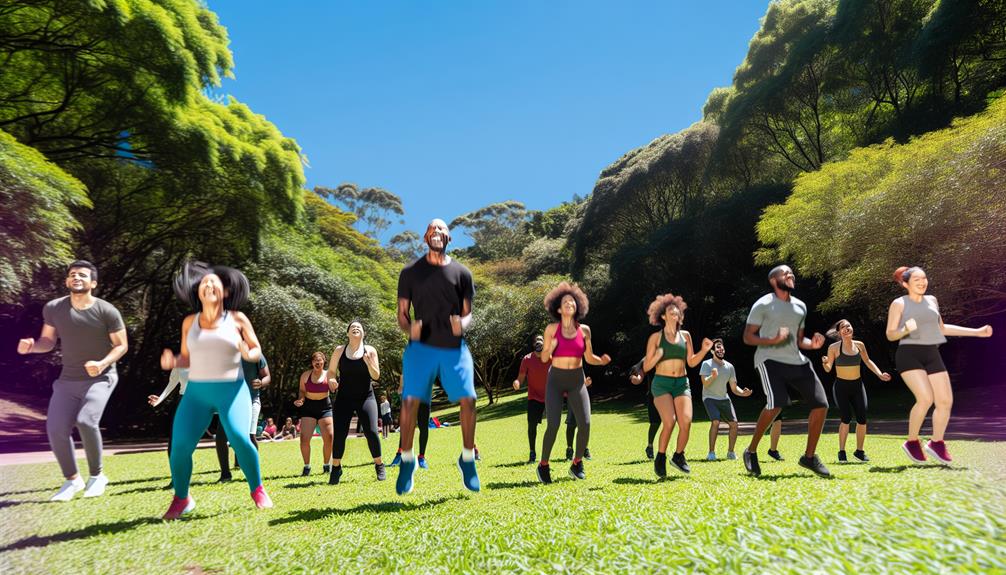
Jumping jacks are an excellent foundational exercise that effectively combines cardiovascular fitness with muscular endurance. These dynamic movements elevate your heart rate while engaging multiple muscle groups, making them a perfect addition to any calisthenics routine. The benefits of jumping jacks extend beyond just physical fitness; they also improve coordination and flexibility, contributing to overall athletic performance.
For beginners, mastering the basic jumping jack is essential, but there are numerous variations to keep your workouts fresh and challenging. You can try half jacks, where you raise your arms only to shoulder level, or star jacks, which involve a more explosive jump and a wider arm spread. These variations not only provide a fun twist but also allow you to target different muscle groups and adjust the intensity of your workout.
Incorporating jumping jacks into your regimen fosters a sense of community, as they can be performed solo or in a group setting. Whether you're warming up or engaging in a full workout, jumping jacks are versatile and accessible, inviting everyone to join in on the journey toward better health and fitness.
Dips
Dips are an excellent bodyweight exercise that primarily targets the triceps, shoulders, and chest, making them a valuable addition to any beginner's calisthenics routine. Understanding the proper technique is essential to maximize benefits and prevent injury. Additionally, exploring various dip variations can help you progress and keep your workouts engaging as you build strength and stability.
Benefits of Dips
One of the most effective bodyweight exercises for building upper body strength is the dip. This compound movement primarily targets the triceps, chest, and shoulders, making it a staple in any calisthenics routine. Dips not only promote muscle engagement but also enhance joint stability, which is essential for overall functional fitness.
The benefits of incorporating dips into your workout regimen include:
- Increased upper body strength: Dips engage multiple muscle groups, leading to significant strength gains.
- Improved muscle definition: Regular practice can result in toned arms and a well-defined chest.
- Enhanced joint stability: Strengthening the muscles around the shoulders helps maintain joint health and reduce injury risk.
- Versatile training options: Dips can be modified to suit various fitness levels, offering progressions for beginners and advanced practitioners.
- Convenient and accessible: All you need is a sturdy surface, making dips easy to perform anywhere.
Proper Technique Overview
Executing dips with proper technique is essential to maximizing their effectiveness and minimizing the risk of injury. Focus on maintaining correct posture alignment throughout the movement. Begin by grasping the dip bars with your palms facing down and your body straight. As you lower yourself, keep your elbows close to your body and slightly bent. Aim for a 90-degree angle at the elbows.
Incorporating effective breathing techniques can enhance your performance. Inhale as you lower your body to keep your core engaged, and exhale as you push back up. This rhythm helps maintain stability and control.
Here's a quick overview of the key elements to remember:
| Key Element | Technique Description | Importance |
|---|---|---|
| Posture Alignment | Keep body straight and elbows in | Reduces shoulder strain |
| Breathing Techniques | Inhale down, exhale up | Stabilizes core and enhances performance |
| Elbow Position | Close to body, slightly bent | Promotes joint safety |
| Range of Motion | Lower to 90 degrees | Maximizes muscle engagement |
Variations for Progression
Progressing in your calisthenics journey involves exploring various dip variations that challenge your muscles in new ways. Dips are an excellent exercise for building upper body strength and can be tailored to match your evolving skill levels. As you advance, integrating variations into your workout routines can keep your training engaging and effective. Here are some variations to contemplate:
- Weighted Dips: Add resistance using a dip belt to intensify your workout.
- Ring Dips: Use gymnastic rings to increase instability and engage stabilizing muscles.
- Korean Dips: Perform dips on a bar positioned lower than your waist for a unique angle.
- Assisted Dips: Utilize bands or machines to support your weight while you build strength.
- Negative Dips: Focus on the lowering phase to enhance muscle endurance and control.
Incorporate these variations into your training splits, adjusting workout duration for effective recovery methods. Additionally, contemplate integrating mobility drills to improve your range of motion, and endurance training for overall performance enhancement. Experimenting with these advanced techniques can transform your circuit training, making your journey both rewarding and fulfilling.
Burpees

How can a single exercise embody both strength and endurance while simultaneously elevating your heart rate? The burpee is a prime example, offering a full-body workout that engages multiple muscle groups and boosts cardiovascular fitness. This dynamic move combines a squat, push-up, and jump, making it a powerhouse in any calisthenics routine.
Burpee variations, such as the half burpee or the burpee tuck jump, allow you to tailor the exercise to your fitness level. Beginners can start with modified versions, gradually incorporating more complex movements as their strength and stamina improve. This adaptability fosters a sense of belonging, as individuals can work alongside others with varying skill levels, all aiming for personal growth.
The burpee benefits extend beyond physical fitness; they also build mental resilience. Completing a set of burpees can instill a sense of accomplishment, enhancing your overall workout experience. As you navigate through this challenging yet rewarding exercise, you become part of a community that values dedication and progress. Embrace the burpee and discover how it can transform not just your body, but your mindset as well.
Mountain Climbers
Engaging in mountain climbers not only elevates your heart rate but also challenges your core stability and builds endurance. This dynamic exercise is a full-body workout that targets multiple muscle groups while improving cardiovascular fitness. Whether you're a beginner or an advanced athlete, mountain climber variations can be easily adapted to suit your fitness level.
The benefits of incorporating mountain climbers into your routine include:
- Improved cardiovascular health: Rapid movement helps boost heart rate.
- Enhanced core strength: Engages the abdominals and stabilizing muscles.
- Increased agility: Promotes coordination and balance.
- Calorie burning: A high-intensity exercise that aids in weight management.
- Versatility: Can be performed anywhere without equipment.
To get started, focus on maintaining a strong plank position as you alternate bringing your knees towards your chest. Experiment with different mountain climber variations, such as slow mountain climbers for beginners or explosive climbers for a greater challenge. By integrating this exercise into your calisthenics routine, you'll not only feel the burn but also experience a sense of accomplishment as you progress in your fitness journey.
Leg Raises
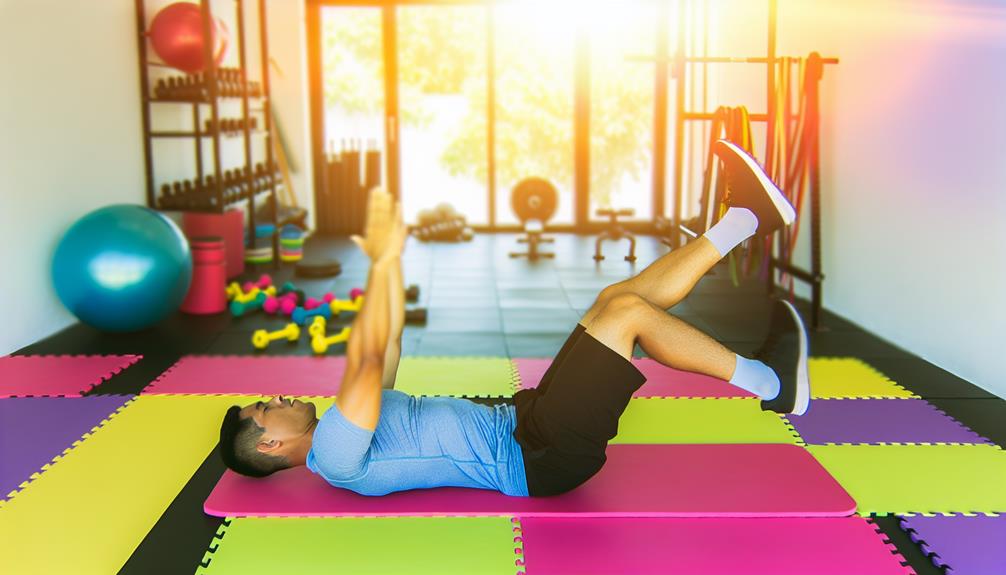
Although they may seem simple, leg raises are a powerful exercise that effectively targets the lower abdominal muscles and hip flexors. This move not only strengthens your core but also enhances your overall stability and posture, making it an essential addition to any calisthenics routine.
To perform leg raises, lie flat on your back with your legs extended. Engage your core as you lift your legs toward the ceiling, then slowly lower them back down without touching the ground. This controlled motion maximizes muscle engagement, ensuring that you reap the full benefits of the exercise.
For those looking to diversify their workout, there are various leg raises variations to explore. For instance, bent knee raises are ideal for beginners, while hanging leg raises provide an advanced challenge that engages even more muscle groups. You might also try side leg raises to target your obliques.
Incorporating leg raises into your routine not only builds strength but also fosters a sense of community among fellow fitness enthusiasts. As you practice and share your progress, you'll discover the supportive environment that calisthenics offers, encouraging you to push your limits together.
Glute Bridges
Glute bridges are an excellent exercise for strengthening the posterior chain, which includes the glutes, hamstrings, and lower back. In this section, we will explore the benefits of glute bridges, discuss proper form techniques to guarantee effectiveness and safety, and outline progression variations to accommodate different fitness levels. Understanding these elements will help you incorporate glute bridges effectively into your calisthenics routine.
Benefits of Glute Bridges
The glute bridge is a powerful exercise that targets the muscles of the posterior chain, particularly the gluteus maximus, hamstrings, and lower back. This movement not only enhances glute activation but also plays a significant role in improving core stability. By effectively engaging these muscles, glute bridges contribute to overall strength and functionality, making them a valuable addition to any calisthenics routine.
Here are some key benefits of incorporating glute bridges into your workouts:
- Enhanced athletic performance: Strong glutes support better power and speed in various sports.
- Injury prevention: Strengthening the posterior chain can help avoid common injuries, especially in the lower back.
- Improved posture: A strong gluteus maximus aids in maintaining proper alignment and posture throughout daily activities.
- Increased flexibility: Regular practice of glute bridges can enhance hip mobility and flexibility.
- Accessible for all levels: This exercise can be modified to suit beginners and advanced practitioners alike, making it inclusive.
Incorporating glute bridges fosters a sense of community as individuals work together toward common fitness goals, promoting both physical and emotional well-being.
Proper Form Techniques
To achieve the full benefits of glute bridges, maintaining proper form is essential. Start by lying on your back with your knees bent and feet flat on the floor, hip-width apart. Your arms should rest comfortably at your sides. As you prepare to lift, focus on your alignment; your shoulders, hips, and knees should form a straight line at the peak of the bridge.
Engage your core and push through your heels as you elevate your hips towards the ceiling. It's vital to avoid overarching your lower back during this movement, as this can lead to strain. Instead, maintain a neutral spine while squeezing your glutes at the top.
Incorporate effective breathing techniques throughout the exercise. Inhale as you lower your hips and exhale forcefully as you lift, which not only helps stabilize your core but also enhances your overall performance.
Progression Variations Explained
Progressing in strength training not only fosters physical growth but also enhances motivation and engagement in your fitness journey. One effective exercise to incorporate into your routine is the glute bridge, which targets the glutes, hamstrings, and core. To guarantee continuous improvement, embracing various progression variations is essential. This approach allows for progressive overload, encouraging muscle adaptation and skill mastery.
Here are five effective variations you can implement:
- Standard Glute Bridge: Begin with the basic form to establish a solid foundation.
- Single-Leg Glute Bridge: Elevate the challenge by lifting one leg, enhancing balance and strength.
- Elevated Glute Bridge: Place your feet on an elevated surface to increase the range of motion.
- Weighted Glute Bridge: Add a barbell or dumbbell across your hips for extra resistance.
- Banded Glute Bridge: Use a resistance band around your knees to activate additional muscles.
Bicycle Crunches
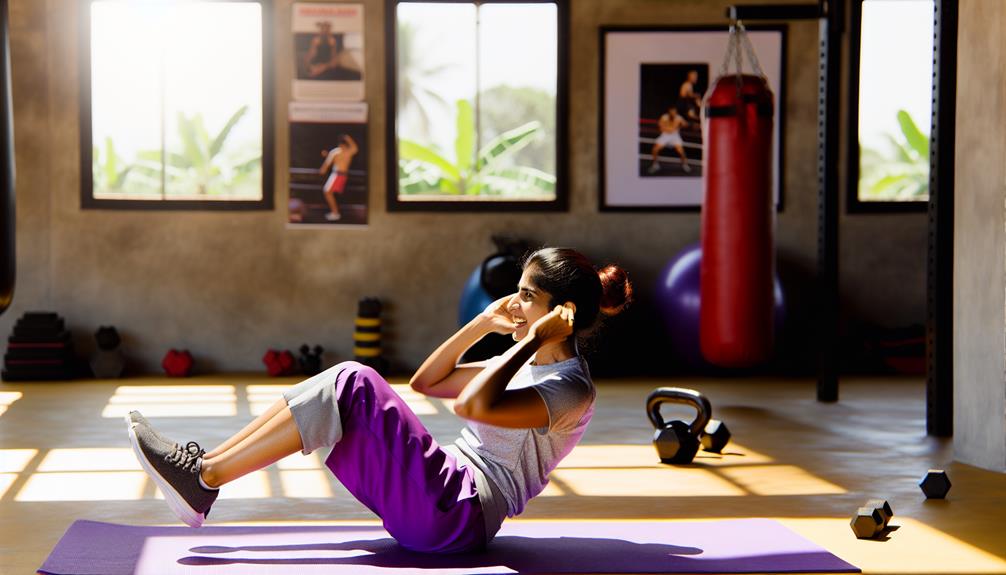
Engaging in bicycle crunches is an effective way to strengthen the core while targeting the oblique muscles. This dynamic exercise not only enhances abdominal strength but also improves overall stability and coordination. As a beginner, incorporating bicycle crunches into your routine offers numerous bicycle benefits, including increased muscle endurance and enhanced athletic performance.
To perform bicycle crunches, lie on your back with your legs lifted and knees bent at a 90-degree angle. Place your hands behind your head, engage your core, and gently pull your shoulder blades off the ground. As you extend one leg, twist your torso to bring the opposite elbow towards the bent knee. Alternate sides in a controlled manner, resembling a pedaling motion.
Bicycle crunches are a fantastic addition to various crunch variations, making workouts more engaging and effective. By consistently practicing this exercise, you'll develop a stronger core, which is essential for maintaining proper form in other calisthenics movements. Remember to focus on quality over quantity, ensuring each repetition is performed with precision. Embrace this exercise, and you'll not only feel empowered but also become part of a supportive community dedicated to fitness and health.
Wall Sits
How can a simple exercise like the wall sit effectively enhance your lower body strength and endurance? Wall sits are an isometric exercise that targets the quadriceps, hamstrings, and glutes while also engaging the core for stability. This straightforward yet powerful movement can be performed anywhere, making it an ideal addition to your calisthenics routine.
To maximize your wall sit experience, consider the following benefits:
- Increased muscle engagement: Activates multiple muscle groups simultaneously.
- Improved core stability: Strengthens the core, providing a solid foundation for other exercises.
- Enhanced endurance: Challenges your muscles to maintain tension over time, boosting stamina.
- Adaptability: Perfect for beginners and can be modified to suit your fitness level.
- Minimal equipment: Requires only a wall, making it accessible for everyone.
Incorporating wall sits into your training regimen can lead to noticeable improvements in your lower body strength and overall fitness. As you progress, aim to increase the duration of your holds, fostering a sense of accomplishment and belonging in your fitness journey.
Cool Down and Stretching
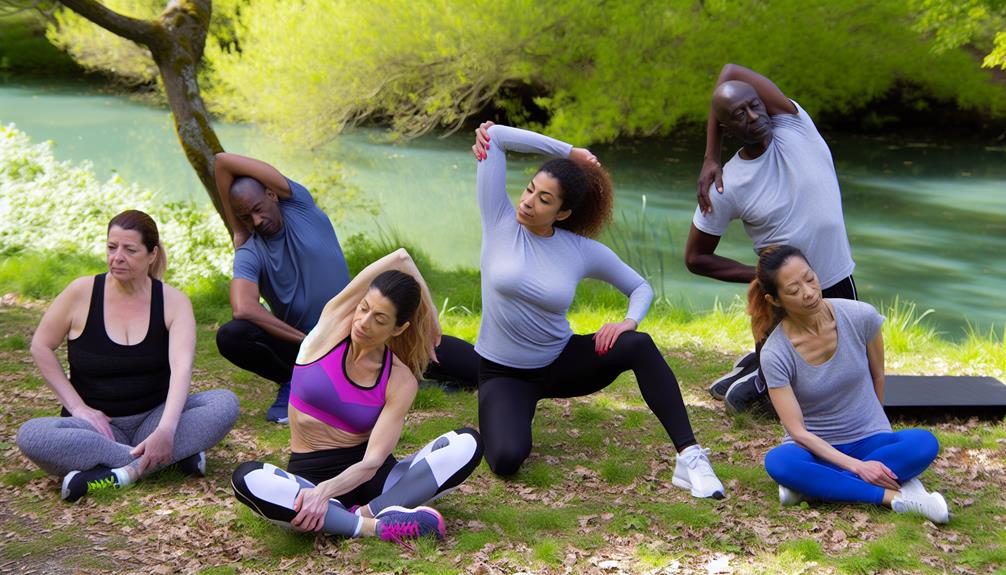
Recovery is a essential component of any fitness regimen, and incorporating a proper cool down and stretching routine can greatly enhance your overall performance and prevent injury. After an intense calisthenics workout, your muscles need time to recover, and this is where active recovery plays a significant role. Engaging in light activities such as walking or gentle cycling helps to gradually lower your heart rate while promoting blood circulation.
Following this, implementing effective stretching techniques is fundamental for maintaining flexibility and reducing muscle tension. Focus on dynamic stretches post-workout, targeting areas that were heavily engaged during your exercises, such as the shoulders, arms, and legs. Incorporate static stretches as well, holding each position for 15-30 seconds to allow your muscles to lengthen and relax.
Tips for Progressing
After completing your cool down and stretching routine, the next step in your calisthenics journey involves understanding how to effectively progress in your workouts. Progressing in calisthenics is not just about performing more repetitions; it's about enhancing your strength, endurance, and overall fitness level. Here's how you can set yourself up for success:
- Establish Clear Goals: Define what you want to achieve, whether it's mastering a specific exercise or increasing your overall strength.
- Utilize Progress Tracking: Keep a workout journal or app to monitor your improvements over time. This helps maintain motivation and accountability.
- Gradually Increase Difficulty: Incorporate variations of exercises or add more sets and reps as you become stronger.
- Listen to Your Body: Pay attention to how your body responds. Adjust your routine to prevent injury and guarantee sustainable growth.
- Engage with Community: Join groups or forums to share your progress and learn from others. This sense of belonging can foster motivation.
Frequently Asked Questions
Can Calisthenics Help With Weight Loss?
Calisthenics can be an effective method for weight loss, primarily due to its bodyweight training approach, which enhances overall strength and cardiovascular fitness. The benefits of calisthenics include increased calorie expenditure during workouts and improved muscle tone, both of which contribute to weight management. Additionally, this form of exercise fosters a sense of community and belonging among practitioners, making it an engaging and sustainable choice for those seeking to achieve their fitness goals.
How Often Should I Practice Calisthenics?
To optimize your calisthenics practice, it is generally recommended to train three to five times per week. This frequency allows for adequate recovery while promoting progress tracking through consistent performance evaluations. Incorporating workout variations keeps your routine engaging and targets different muscle groups effectively. As you advance, adjusting the intensity and complexity of exercises can further enhance your results, ensuring a sense of belonging within the fitness community as you share your journey.
Is Calisthenics Suitable for All Fitness Levels?
Calisthenics is indeed suitable for all fitness levels, as it emphasizes progressive training through bodyweight exercises. Beginners can start with basic movements, gradually increasing complexity and intensity as they build strength and confidence. This adaptability fosters a sense of belonging among practitioners, as individuals can tailor their workouts to meet personal capabilities and goals. Ultimately, calisthenics encourages a supportive community that evolves alongside each participant's fitness journey.
What Equipment Do I Need for Calisthenics?
Calisthenics primarily relies on bodyweight training, making it accessible without the need for extensive equipment. However, incorporating a pull-up bar, resistance bands, and a mat can enhance your workouts considerably. These tools not only facilitate a variety of exercises but also amplify the calisthenics benefits, such as improved strength, flexibility, and coordination. By utilizing minimal equipment, individuals can foster a sense of community and support, making fitness an inclusive journey for all.
How Can I Prevent Injuries While Doing Calisthenics?
Preventing injuries during calisthenics is essential for a safe and effective workout. Implementing proper warm-up techniques, such as dynamic stretches, prepares your muscles and joints for activity. Additionally, incorporating recovery strategies like adequate rest, hydration, and nutrition promotes muscle healing and performance. Listening to your body and gradually increasing intensity can further mitigate injury risks. By prioritizing these practices, you foster a supportive environment that encourages longevity in your fitness journey.

